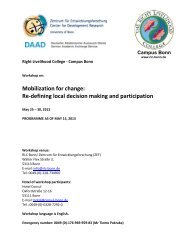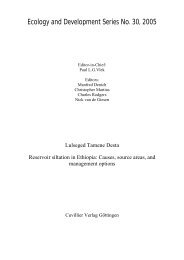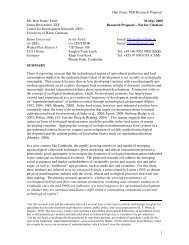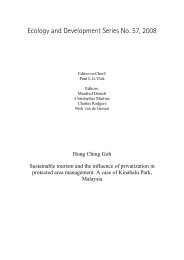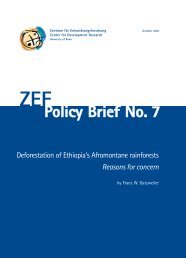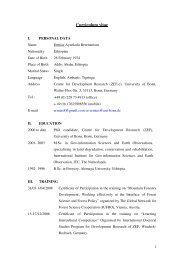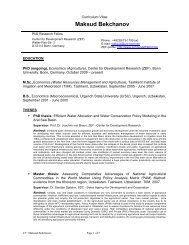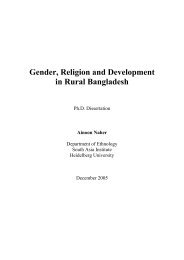Ecology and Development Series No. 10, 2003 - ZEF
Ecology and Development Series No. 10, 2003 - ZEF
Ecology and Development Series No. 10, 2003 - ZEF
- No tags were found...
Create successful ePaper yourself
Turn your PDF publications into a flip-book with our unique Google optimized e-Paper software.
Impacts of human use on the forest vegetationseveral species from the stumps after coppicing was observed in the managed forests. Themost notable species in this regard is Maytenus gracilipes, which remained unaffected bymanagement activities (Figure 5.1). For most other species, however, the chance for theregenerated plants to mature is nil, since the regenerated vegetation is removed once ortwice a year. Such continued removal of the understorey vegetation leads to a decline inspecies diversity. This is because such recurrent clearing limits the capacity for speciesregeneration from the seedling <strong>and</strong> soil seed banks, <strong>and</strong> the coppicing ability of stumpgradually diminishes, decreasing the species diversity of the older managed forests (seeSEMIFOR-OLD <strong>and</strong> SEMIFOR-PLAN, Tables 5.1 <strong>and</strong> 5.3). Though the older managedforests have a lower species diversity index, they tend to have a high species evenness(Table 5.3). From this, it appears that the dominance of few plant species in the forestvegetation is more pronounced at the early stage of disturbance (Crawley 1997).Some of the species that totally disappeared in all managed forests are ofconservation interest. For instance, Vepris dainelli is endemic to Ethiopia (Mesfin 1991b),while Prunus africana is listed on the IUCN Red Book as a vulnerable species (IUCN2002). Some species are represented only by seedlings, like Teclea noblis. On the otherh<strong>and</strong>, there are some species newly introduced in the managed forests, which do notnaturally belong to the forest ecosystem. These include cultivated species like Catha edulis,Citrus medica <strong>and</strong> Ricinus communis (Table 5.1), <strong>and</strong> pioneers like Physalis peruviana <strong>and</strong>Vernonia amygdalina.The old secondary forest (SECFOR) is restored in terms of species diversity,composition <strong>and</strong> structure, <strong>and</strong> becomes quite similar to undisturbed natural forest(NATFOR) within about 50 years (Figure 5.1; 5.2; Table 5.3; 5.4 <strong>and</strong> 5.<strong>10</strong>). The recoveryof the forest in terms of species diversity <strong>and</strong> composition could be attributed to itsproximity to the natural forest, which certainly has been the main source of propagules. Thel<strong>and</strong>-use system around the old settlement area may also have been managed forest forcoffee production. Other studies also showed similar convergence in species diversity <strong>and</strong>composition between old growth forest <strong>and</strong> ab<strong>and</strong>oned shade coffee plantations after 30years (Marcano-Vega et al. 2002), ab<strong>and</strong>oned cropl<strong>and</strong> after 50 years (Grau et al. 1997),<strong>and</strong> ab<strong>and</strong>oned pasture after 18 years of succession (Guariguata et al. 1997).92



